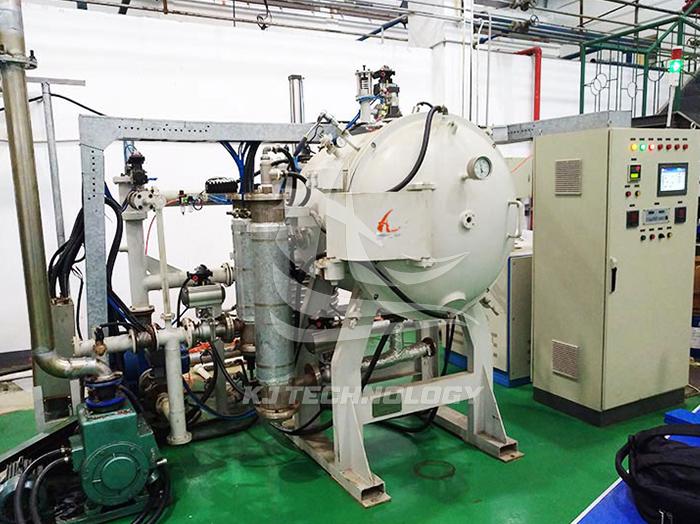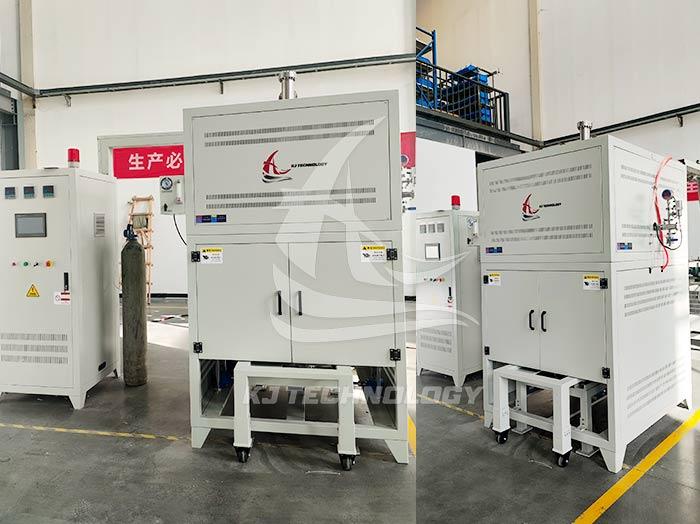Vertical high vacuum hot pressing electric furnace
 08-20-2025 Author: KJ technology
08-20-2025 Author: KJ technology
Vertical high vacuum hot press electric furnace is an advanced material processing equipment that combines vacuum environment, hot press forming, and high-temperature sintering functions. The following provides a detailed introduction from five aspects: structural characteristics, working principle, technical parameters, application fields, and advantages:
1. Structural characteristics
Vertical double-layer shell design: The outer layer is a water-cooled interlayer, and the inner layer is made of high-temperature resistant materials such as high-purity alumina fibers, ensuring the stability and safety of the equipment at high temperatures.
Vacuum system: equipped with mechanical pumps and high vacuum units, it can achieve ultra-low vacuum degree with a basic pressure of 5 × 10 ⁻¹ Pa to 2 × 10 ⁻⁵ Pa, effectively eliminating air and other gases around the material, and avoiding adverse reactions such as oxidation and volatilization of the material at high temperatures.
Heating system: using heating elements such as graphite carbon tubes, silicon carbon rods, or silicon molybdenum rods, achieving precision control of ± 1 ℃ through a PID temperature control system, supporting multi-stage programmed heating curve settings, and meeting the heat treatment needs of different materials.
Pressure system: The hydraulic system drives the pressure head to apply pressure to the material, ranging from several tons to hundreds of tons, and can achieve one-way or two-way pressure to meet different process requirements.
Cooling system: Integrated oil agitator and airflow circulation device. The cooling fan drives the airflow to cool through the heat exchanger and form a quenching airflow. The workpiece is rapidly cooled through directional air inlet holes to improve production efficiency.
2. Working principle
Vacuuming: The vacuum system extracts air from the furnace, creating a vacuum or specific atmospheric environment.
Heating: The heating system begins to work, using resistance heating or induction heating to quickly raise the temperature inside the furnace to the set process temperature.
Pressurization: In a high-temperature environment, the hydraulic system drives the pressure head to apply pressure to the material, allowing the material to achieve powder densification or hot pressing of the workpiece under the combined action of high temperature and pressure.
3. Application Fields
Aerospace: Used for manufacturing high-performance components such as titanium alloys and nickel based alloys. By precisely controlling the hot pressing process parameters, these components have excellent mechanical properties and high temperature resistance, ensuring stable operation in extreme space environments.
Electronics industry: Prepare high-purity and high-density ceramic or metal packaging materials to provide reliable protection for integrated circuits and improve the stability and reliability of electronic products.
Powder metallurgy: achieving densification of powders, improving the density and mechanical properties of materials.
Functional ceramics: used for vacuum sintering of metals such as transparent ceramics and industrial ceramics, as well as alloy materials composed of refractory metals, and high-temperature sintering of ceramic materials such as silicon carbide and silicon nitride.
New energy: used for processes such as sintering of lithium battery electrodes and annealing of photovoltaic silicon wafers.
4. Advantages
Highly automated: using programmable logic controller (PLC) for automation control, one click start can achieve full automation operation. The human-machine interface control system is equipped with a liquid crystal display screen, which displays the real-time operation status of the equipment, making it easy for operators to monitor and adjust process parameters.
Precise control: Advanced control systems can monitor and adjust parameters such as temperature, pressure, and vacuum inside the furnace in real time, ensuring the accuracy and repeatability of the hot pressing process.
Efficient and energy-saving: By optimizing the design of heating and cooling systems, energy utilization efficiency is improved and production costs are reduced.
Environmental protection and safety: The equipment operates in a vacuum environment, effectively avoiding the oxidation and volatilization of materials at high temperatures, reducing the emission of harmful gases, and meeting environmental protection requirements. At the same time, the equipment is equipped with multiple safety protection devices to ensure the safety of operators.








